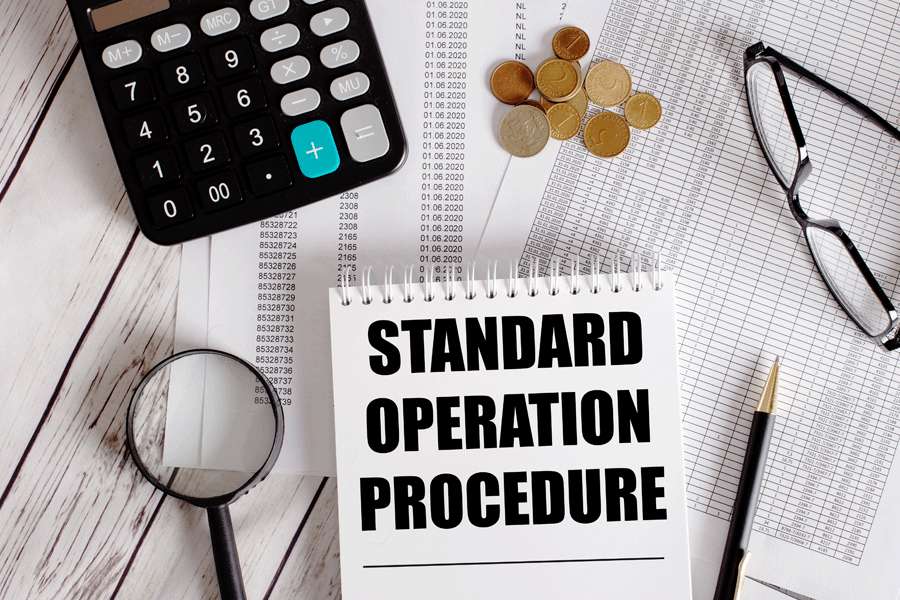Most organizations and institutions have a strict set of guidelines for how to conduct certain activities. If this sounds like your business, standard operating procedure (sop) templates will come in handy for you by helping you maintain desired standards in your operations. Read on to find out what SOPs are, why they are essential, and how you can create them.
What Are SOPs? (Standard Operating Procedures)
A Standard Operating Procedure (SOP) is a document that a company or organization creates to highlight how things need to be done during certain processes. It provides exact steps and explanations of what needs to be done for these processes to be completed as planned, to ensure consistency and repeatability in every performance.
SOPs often come in handy when a task is complicated or requires a precise sequence of steps, and employees cannot remember every detail of the procedure by heart. In some cases, they are used to protect employees when performing processes that may include hazards or the possibility of injury.
You can thing of an SOP as a script. In the service industry, for example, an SOP may include a list of responses with a spoken-word formula for workers to use when responding to customer concerns. The following are the main characteristics of an SOP: They are:usually in written form
- usually in written form
- used in the daily running of the organization
- created from an approved template by management
- reviewed regularly
- titled and numbered so they can be easily located
- archived
What Is the Format of a Standard Operating Procedure Template?
The standard SOP has two parts, which are:
The Identifying Information
Also called the metadata or document control information, the identifying information includes front-page details that identify the organization and the document. The details, which are often presented in a table at the top of the document or on the front page, can include the:
- company name and logo
- SOP title and document number
- version number
- name, job title, and signature of the approving party
- effective date
- review dates
- template references
SOP Content
Once the company and document have been identified, the next part outlines the content of the SOP itself. While different documents may vary, most include the following sections:
- The purpose of the SOP
- The party responsible for it
- The policy or standard it fulfils
- Its scope, i.e. what individuals, groups, or departments the SOP apples to
- The step by step procedures
- References to regulations and policies that support the procedure
- Term and jargon definitions
- Evaluation criteria that may be used to determine effectiveness
- A list of revisions made to the document
How to Write a Standard Operating Procedure
The following steps should help you create an effective SOP for your organization:
Step 1: Establish an end goal
Determine what you want to achieve through your SOP and the procedures that will make this possible.
Step 2: Choose a suitable format
There are 3 formats to choose from, namely the:
- Simple step format – Numbered or bulleted, with short, easy-to-follow sentences
- Hierarchical step format – Numbered or bulleted, with different ranked subsets
- Flowchart format – Used for unpredictable processes. Presents possible outcomes for different steps through a map.
Step 3: Write the SOP
Prepare the two sections of your SOP, the identifying information and SOP content.
Step 4: Review and edit the document
Have every stakeholder review the document and test it for accuracy, cohesiveness, and extensiveness.
The Importance of Standard Operating Procedures
The following are the top benefits of having an SOP in your company or organization:
- Best Practices. An SOP ensures that the members of your team only pick the best practices when performing company processes. It also allows them to handle different problems and emergencies as they should.
- Automatic Decisions. Having clear cut procedures and response to any problems that may arise during production provides employees with an automatic decision making manual.
- Streamlined Results. Through an SOP, your company can streamline all its processes, with all employees working with the same set of instructions to create cohesive results.
- Efficient Training. A detailed SOP can come in handy when training new members since all the regulations and guidelines are already established and can easily be referred to.
Standard Operating Procedure Templates
A standard Operating Procedure template is a guide that can be used to create a document highlighting the instructions of conducting certain company processes.
Standard Operating Procedure Examples
Standard Operating Procedure examples are sample documents that demonstrate how a company can summarize clear cut instructions for different production processes.
Streamlined procedures and systems are put in place to ensure efficient operations within a business or organization. Because of how complex they can be, you can’t expect your employees to memorize them all, and instead should provide the, with a Standard Operating Procedure (SOP) Template.
A well-written SOP informs your employees on how to perform certain tasks correctly while tackling any problems that may arise. In doing so, it allows you to achieve consistency and quality in your results.
Looking For Document Management System?
Call Pursho @ 0731-6725516
Check PURSHO WRYTES Automatic Content Generator
https://wrytes.purshology.com/home
Telegram Group One Must Follow :
For Startups: https://t.me/daily_business_reads




